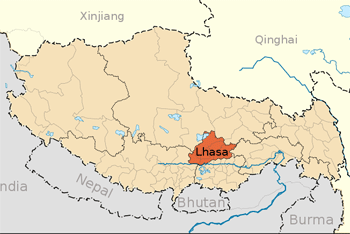Asia > Tibet: Weather, Map, Costs and Travel Guide

Tibet : When and where to go?
Click on a city for complete climate and weather tables
| Town | Jan | Feb | Mar | Apr | May | June | July | Aug | Sept | Oct | Nov | Dec |
| Lhasa |  |  |  |  |  |  |  |  |  |  |  |  |
Tibet: Climate & Weather
The main feature of Tibetan climate is the great range of temperatures possible during a single day. The nights are cold with temperatures below 0°C, but it can be hot, up to 38°C at noon.
Snow is rare except on the Himalayan border, but the winters are very harsh. July and August are the rainy months. The centre of Tibet has milder weather.
The best time to visit Tibet is May and June and also in September and October when the weather is dry and sunny with mild temperatures during the day.
Weather today

Clear
Wind: 3 km/h
Precipitation forecast: 0 mm
> Full report and 7-days forecast
Data updated at 21:09 (local time)
At that time, the weather was:
 10 °C / Overcast
10 °C / Overcast
Tibet: Map

Sponsored links
What to do in Tibet
The invasion of Tibet by China in 1950 has only reinforced the aura of legend that has always surrounded this country: Re-opened to tourism since June 2008, it is fascinating for various reasons. Lhasa is a jewel in its crown: The Potala Palace, Jokhang Temple, the market, the countless pilgrims, all will leave you with unforgettable memories.
A little further out, in Shigatse, you can admire the amazing statue of Buddha in the Tashilhunpo monastery. From there a bus takes you to Sakya, with its monasteries where many religious relics can be discovered. You can spend the night there before going on to the Everest base camp: A favourite destination for those who enjoy trekking, it will allow you to see the amazing Everest landscapes.
In addition, the small and pleasant town of Gyantse will attract you with its strong Tibetan identity, despite the Chinese presence, and the Stupa surrounded by chapels. Whatever your chosen itinerary, you will inevitably be surprised by the beautiful scenery, the permanent presence of spirituality in everyday life, the original architecture of the buildings and the character of its people, both welcoming and warm.
Tibet: The basics
A visa for China is required, together with a special permit issued by the Tibetan Tourism Bureau that you will only get if you travel in groups of more than 5 people. Finally you will also need a travel permit for accessing certain regions.
The currency in circulation is the RMB (renminbi, or Yuan). Take note, there are few currency exchange services within the country. In contrast, the euro is becoming more accepted in the larger towns.
Board and lodging can cost as little as €10 per day.
A comfortable double room will cost you less than €30.
In relation to the food, do not expect haute cuisine, meals are simple, but some Tibetan specialties are delicious and cost less than €5 per meal.
In relation to health, it is advisable to be in good physical shape before starting your travel: The altitude is the main risk and can cause acute mountain sickness. Take your time to acclimatise, Lhasa is at 3,700 m.



